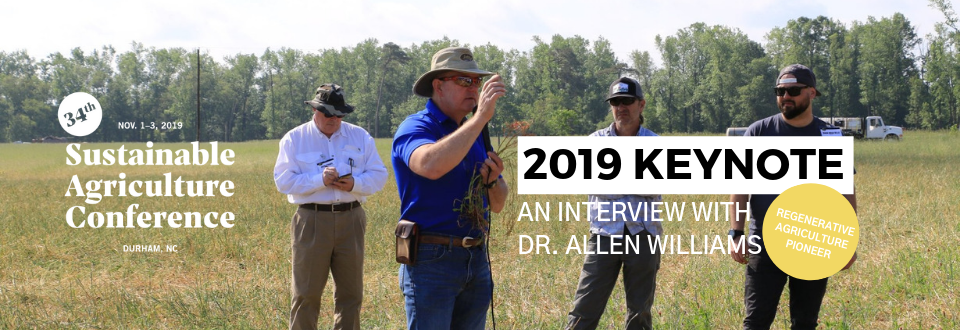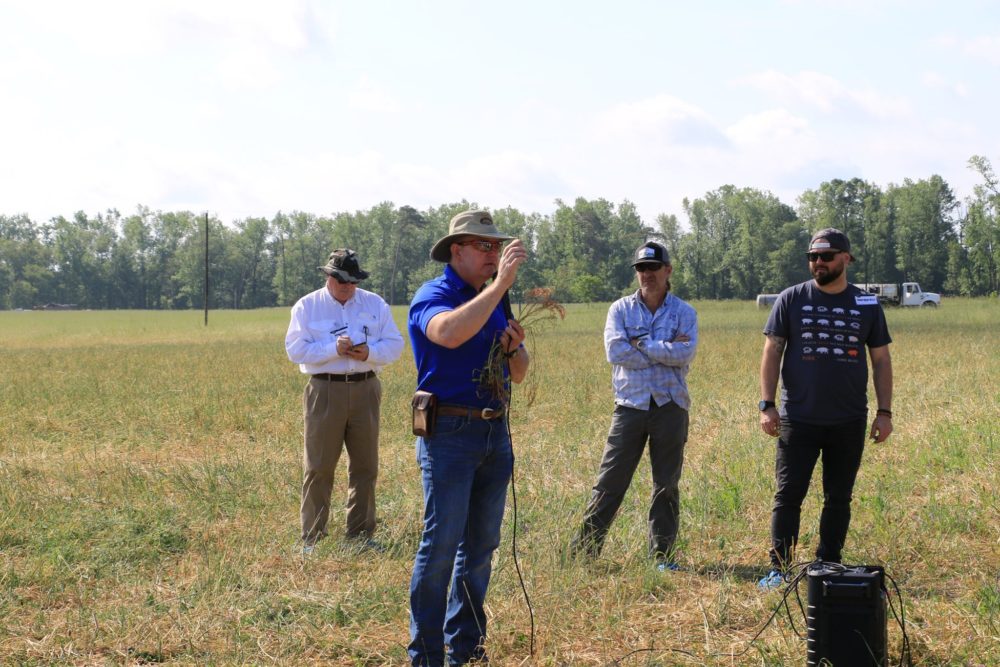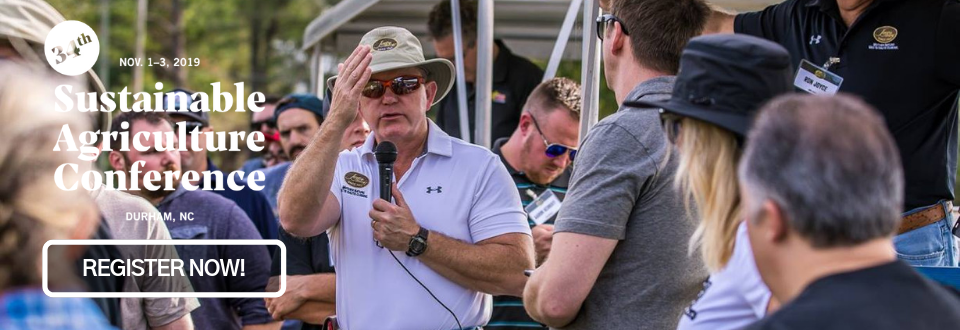by CFSA | Thursday, Aug. 29, 2019 –

Dr. Allen Williams is a sixth-generation family farmer and expert on regenerative agriculture and grazing, soil health, adaptive foraging, pasture-based meat production, the grass-fed market, and alternative marketing systems, among other subjects. He personally pioneered many of the first grass-fed protocols and forage finishing techniques. For these reasons and more, we are thrilled to bring Dr. Williams as the keynote speaker of our 2019 Sustainable Agriculture Conference.
Though he currently lives in Mississippi, where he owns a grass-fed beef operation, Dr. Williams has deep roots in the Carolinas. His ancestors first started their family farm in South Carolina in the year 1842. He began his education at Clemson, where he earned his BS and MS in Animal Science. He later went on to earn his Ph.D. in Livestock Genetics from LSU. He is also a longtime partner and Chief Ranching Officer of Joyce Farms in Winston-Salem. A respected researcher, (self-described) “recovering” academic, and writer, Dr. Williams has published over 400 articles and the book Before You Have a Cow. We recently sat down for an in-depth conversation with Dr. Williams about all things regenerative and adaptive in the Carolinas and beyond.
CFSA: You are both a farmer and an expert on regenerative farming and ranching. What is one thing you wish more farmers knew about regenerative practices?
Dr. Allen Williams: The most important thing is that it’s not a hard or difficult thing to do. And that it doesn’t cost you a ton of money–actually you make money in the transition. The number one reason farmers don’t make a move in this direction is their initial perception is that regenerative agriculture is going to be hard and require a lot more work and that it will be like transitioning to organic, where you’ve got to be prepared to lose money over the first two to three years before you finally make money. None of those things are true.
You work with many farms across the Carolinas. How widely have regenerative practices been adopted across this region?
Williams: I would say that North Carolina is definitely ahead of South Carolina in that regard. I don’t have the best explanation for that, other than there has been better support from many levels in the state of North Carolina. I’d say that in North Carolina, less than ten percent of all farmers have adopted regenerative practices and in South Carolina it is only a handful, probably no more than two to three percent.
What do you think it will take before we start seeing more farms adopt regenerative practices?
Williams: Well, you can’t adopt what you don’t know. That’s really the bottom line. My partners and I speak to groups of farmers and ranchers every day about regenerative agriculture, and one of the first questions that we always get is, well, if this is so wonderful–why isn’t everybody doing it? There is nothing on God’s green earth that everybody does. Now if you ask why aren’t more doing it now? I can give you a very good answer–they simply haven’t heard about regenerative ag or heard enough to know what to do.
Here’s how to get more people to adopt in a nutshell. Every good marketing agency knows it takes at least six to eight impressions before a consumer will pull the trigger on buying a product. Very, very few people buy something the first time they see an ad for it. You have to see ads repeatedly, and in different ways, before you finally decide that’s a product you might need. Farmers and ranchers are no different. We’re consumers as well. We rarely make any change in our operations after the first time we hear about something.
Farmers tend to be risk-averse. Many of us face heavy debt loads and peer pressure. We hear voices from all over–from our families to neighboring farmers and ranchers, to lenders to the allied industries that sell us things. Telling us oh don’t do that–you need this instead. And so many farmers and ranchers are confused.
We just have to keep making impressions by putting this in front of farmers in various forms, whether it’s articles, videos, or someone speaking about it at a conference. Several impressions will spur them to seek out more in-depth learning. Next, they need a workshop where they can see, touch, feel, and hear for themselves and get immersed in regenerative practices. Then they need a school. There are a number of different schools out there. Ours is the Soil Health Academy–a three-day school that is very in-depth and hands-on. Farmers need that immersive learning experience because they’ve got to feel comfortable and capable if they’re going to make a change.
For the last step–they need follow up. Because even after they go to a school they are still going to hit speed bumps along the way. When they run into hiccups, they need consultants and a supportive network to go to for help and encouragement. Schools help forge and form interactive networks among farmers who are making this transition. Through those networks, they can share their challenges and discover new ways that others are meeting those challenges.
Your address at SAC is titled: Adaptive Stewardship: Your Key to Regeneration & Profitability. What is adaptive stewardship and what are some of the major impacts that farmers and ranchers are seeing after adopting this approach?
Williams: My partners and I, beyond being consultants and teachers, are practicing farmers and ranchers ourselves. Through our practice and the boots-on-the-ground consulting work that we’ve done on thousands of farms all over the world, we’ve developed what we call the adaptive stewardship approach. Basically, what that means is that when you deal with nature and with biology, we must take an adaptive approach. We are never presented the same thing day-in and day-out, year-in and year-out. It’s always changing. There is no such thing as normal. Most programs developed for farmers and ranchers are what we call prescriptive or formulaic in nature. Those methods won’t work for long, so you have to learn how to be adaptive.
“Most programs developed for farmers and ranchers are what we call prescriptive or formulaic in nature. Those methods won’t work for long, so you have to learn how to be adaptive.”
In being adaptive, we have to be good stewards of the soil, the microbes in the soil, the animals, the plants, and everything else that we’re in charge of. Within adaptive stewardship, we have three rules that hold true no matter where you are in the world: the rule of compounding, the rule of diversity, and the rule of disruption. Those are the three core components of adaptive stewardship.
The rule of compounding means that in nature, which is what we deal with every day as farmers, there are never any singular effects. Everything that we do, every decision that we make, produces a series of compounding and cascading effects. And those effects are never neutral. They are either positive or negative. So the good thing is–we control that by what we do. But, we have to be aware. So we have to recognize and ask ourselves: if I till; if I spray this chemical; if I apply this fertilizer; if I graze this way–am I going to be creating positive compounding effects or negative compounding effects?
The rule of diversity means that nature never creates a monoculture. Anytime nature is in control, nature creates and encourages diversity and complexity. From microbes to insects, to plants, to animals, to birds. Everything is diverse and complex. We are the only creature on the face of the earth that creates a monoculture. So in order to redevelop fully functioning ecosystems, we have to think about, in our farming and ranching practices, the question of how we can reintroduce diversity.
“We are the only creature on the face of the earth that creates a monoculture.”
Finally, the rule of disruption is that nature is incredibly resilient and responds well to challenges, just like our bodies. If you want to be an elite athlete, you cannot do the same exercise routine at the same intensity and duration and expect different results. You have to routinely alter your exercise routine to challenge your mind and body to get bigger, faster, stronger, or gain greater endurance. Nature is the same. Our bodies are biology, nature is comprised of biology and just like our bodies can get stagnant and lazy, nature can get stagnant and lazy as well if we’re doing the wrong thing. So we need to be able to introduce what we call ‘planned purposeful disruptions’ that allow nature to develop resilience.
You’ll also make the argument that this approach can improve the profitability of a farm. Now listening to those rules, people might think, well this is going to take a lot of time and effort to learn how to practice these new techniques. What is the profitability argument for regenerative agriculture?
Williams: In 2018, we did an analysis for the average corn and soybean farmer in the U.S. using USDA ERS statistics. We went to the USDA database and looked at all the cost parameters, yield parameters, and everything else for corn and soybean farmers across the U.S.
Last year, the national yield in corn was a record-breaking 194 bushels per acre. In spite of taking in the greatest yield ever, the average corn farmer, minus subsidies and crop insurance payments, made negative $63 an acre. The average soybean farmer, minus payments, only made $11 per acre. And the average cow-calf producer only netted about $25 to $30 an acre last year.
“Now, I’m sorry, but you do all that work and look at what you lost or what you barely made. That’s untenable.”
Now, I’m sorry, but you do all that work and look at what you lost or what you barely made. That’s untenable. How can you support your family? How can you pay your debt? That’s why the vast majority of farmers today have to have annual operating loans. They can’t afford their own fuel, seed, fertilizer, and living expenses. That’s a sad place to be.
However, contrast that with what regenerative farmers and ranchers can do. We have clients using what we call stack enterprises or multi-enterprise systems that are netting anywhere from $1,200 to more than $4,000 per acre. I’ll give you an example. A farmer named Adam Grady in Kenansville, North Carolina in 2018, just his second year of regenerative agriculture, on 1200 acres saved $161,000 in input costs. And we have farmers in Arkansas, Mississippi, Tennessee, and many other places that saved more than a million dollars in input costs last year by transitioning to regenerative.
It doesn’t cost you–it pays and it can pay you in your very first year. I can also tell you, because we’ve run these numbers, that the investment that people make in regenerative ag in education, schools, consulting, and then any infrastructure that they may need like additional water or fencing resources, they average a minimum of twenty to one return on their investment.
At SAC, you will also be teaching a workshop called Regenerative Grazing: Your Path to Profitability and Quality of Life. Who should come to the workshop and what are some of the anticipated takeaways?
Williams: Anybody that has even a modicum of interest in regenerative agriculture should come. You will get in-depth exposure to what it’s really all about and how you can think about implementing it in your operations. And for those that have already started the transition and are somewhere in that process, it will benefit you as well. After you made those initial steps in years one through five, where do you go from there? We’ll cover the next steps and offer very practical knowledge on how to continue making progress.
You’ll leave the workshop with some things you can take back home and immediately implement on your operations. We’ll talk about how this positively impacts profitability. We’ll talk about all of the different opportunities that are currently available along with some emerging opportunities that many farmers and ranchers are unaware of. You’ll also have an opportunity to ask questions and get answers. This workshop is going to be very interactive. We’re going to give a lot of information and resources you can take home including things to read and short films to watch, how-to videos, and links to helpful organizations and associations.
Climate change adaptation and mitigation with livestock is one of the central themes of SAC this year. Oftentimes ranchers and farmers, and their methane-producing cows, get a bad rap as a contributor to climate change. But regenerative agriculture is seen as a potential solution to the problem. What does the research indicate?
Williams: The bottom line is that poor grazing and poor farming both create a lot of issues relative to the problem. But good farming and grazing practices, what we like to call regenerative and adaptive, are hugely beneficial. As a matter of fact, they present the greatest opportunity to moderate our climate very rapidly. This is not a highly technical or difficult solution to this global problem. It is an easy and quickly implementable solution. And, by the way, it’s pretty darn cheap compared to all of the other myriad solutions that are being proposed out there that cost billions or trillions of dollars.
“The bottom line is that poor grazing and poor farming both create a lot of issues relative to the problem. But good farming and grazing practices, what we like to call regenerative and adaptive, are hugely beneficial.”
What we know, and I’ll be presenting some of the specific data at the conference, is that with adaptive grazing, we sequester significant amounts of carbon. Regenerative agriculture basically creates a true carbon sink. I’ll expound on why we know that during the conference and address how much of a carbon sink we are creating.
Relative to the methane issue, there are many different things that are emitting methane into the atmosphere on a daily basis. Do ruminants emit methane? Yes, it’s a natural part of their digestive process. I’ll come back to that. The form of farming that emits the greatest amount of methane globally is rice farming because you’ve got flooded fields. Rice farms all over the globe emit huge amounts of methane into the atmosphere. Because of severely degraded soils, many row crop fields are now anaerobic. Anaerobic soils emit methane. So we are seeing a lot of methane emissions from normal row cropping operations. Whenever we have these significant flooding events like we’ve had all this year in the Midwest, where a lot of farmland is still in water, all of that farmland is emitting methane. Swamps also emit methane through a natural process.
They just released a peer-reviewed article showing that oil fracking is creating far more methane emissions than they ever realized. So we’re getting a lot of methane emitted through the fracking enterprises.
Now here’s the deal–all ruminants wild or domestic emit methane. That is a part of their natural digestive process. And prior to having all the domesticated cows and so forth in North America or even anywhere else in the world, we had hundreds of millions of wild ruminants globally. And they were emitting methane. Now if their emission of methane in their natural digestive process is an issue, then we’ve had this issue for many, many millennia. It’s been an ongoing issue. Why is it all of a sudden now a problem that ruminants emit methane?
Methane is one of the required gasses in our atmosphere. We don’t want zero methane, just like we don’t want zero nitrous oxide or hydrogen in our atmosphere. It’s the balance that we’re talking about here. No gases are bad. It’s just bad if they’re out of balance. So the problem is, is that we have so severely degraded our soils that the microbes like the methanotrophs that consume this methane, whether it’s emitted from flooded fields, swamps, ruminants, wild and domestic or whatever, these methanotrophs and other microbes use that methane in the natural process. It never was a problem. It’s only a problem now because of poor farming and ranching practices. And if we correct those, methane is no longer an issue.
“It’s only a problem now because of poor farming and ranching practices. And if we correct those, methane is no longer an issue.”
When I get this question from conservation groups I say, “If cow methane emission is an issue and we need to get rid of all cows globally, then we haven’t solved the problem because we’ve still got a whole bunch of wild ruminants around the world. What do we do with them? Are you advocating that we slaughter all the elephants, all the wildebeests, all the elk and so on and so forth.” And of course they look at you with their mouths gaping open and their faces aghast. Well, one conclusion leads to another. If you want to get rid of the methane problem and it’s caused by ruminants, we have to eradicate the wild ruminants as well.
What call to action would you offer to farmers and other members of this community who support sustainable agriculture right now?
Williams: Being a multigenerational farmer who represents the sixth generation from my family and really cherishes that heritage, my call to action is this: We are fast losing our family farms across the nation. As everybody knows, our rural economies have eroded and crumbled to the point that many of our rural towns and communities are mostly boarded up and we are seeing a farm debt crisis. We are also seeing a crisis in depression and suicide among farmers in the U.S. today as we’ve never seen before. Regenerative agriculture represents an opportunity to change every bit of that. It’s an opportunity to get out of debt and stay out of debt. It’s an opportunity to vastly improve your quality of life. Let’s have farms and ranches that continue that generational heritage and repair and rebuild our rural economies.
Don’t Miss Hearing Dr. Allen Williams at SAC 2019
Register for Dr. William’s pre-conference intensive on Friday, November 1 to participate in Regenerative Grazing: Your Path to Profitability and Quality of Life.
That same night, Dr. Williams will deliver his keynote address, Adaptive Stewardship: Your Key to Regeneration & Profitability during the Local Food Feast dinner which will take place from 6:30–9 p.m. This is arguably the biggest local food feast in the Southeast every year with over 500 members of our farming community in attendance. It’s an opportunity to learn from this nationally respected expert while celebrating our hard work with delicious food and excellent company.
 Don’t miss this event! If you are coming for workshops for Saturday and Sunday, plan to get there early and buy a meal ticket or, if you are there just for Friday pre-conference programming, please plan to stay and attend the dinner. Tickets for Local Food Feast dinner are included in our Everything Package passes.
Don’t miss this event! If you are coming for workshops for Saturday and Sunday, plan to get there early and buy a meal ticket or, if you are there just for Friday pre-conference programming, please plan to stay and attend the dinner. Tickets for Local Food Feast dinner are included in our Everything Package passes.
Learn More
Dr. Williams is featured in a short documentary by filmmaker Peter Byck. Givers & Takers profiles how Dr. Williams helped South Carolina farmer Don Jackson transition from continuous grazing to Adaptive Multi-Paddock (AMP) grazing and the incredible impact this change had on the amount of forage he could produce, the improved health of their cattle, and the increase in beneficial insects.
All photos courtesy of the Soil Health Academy.



